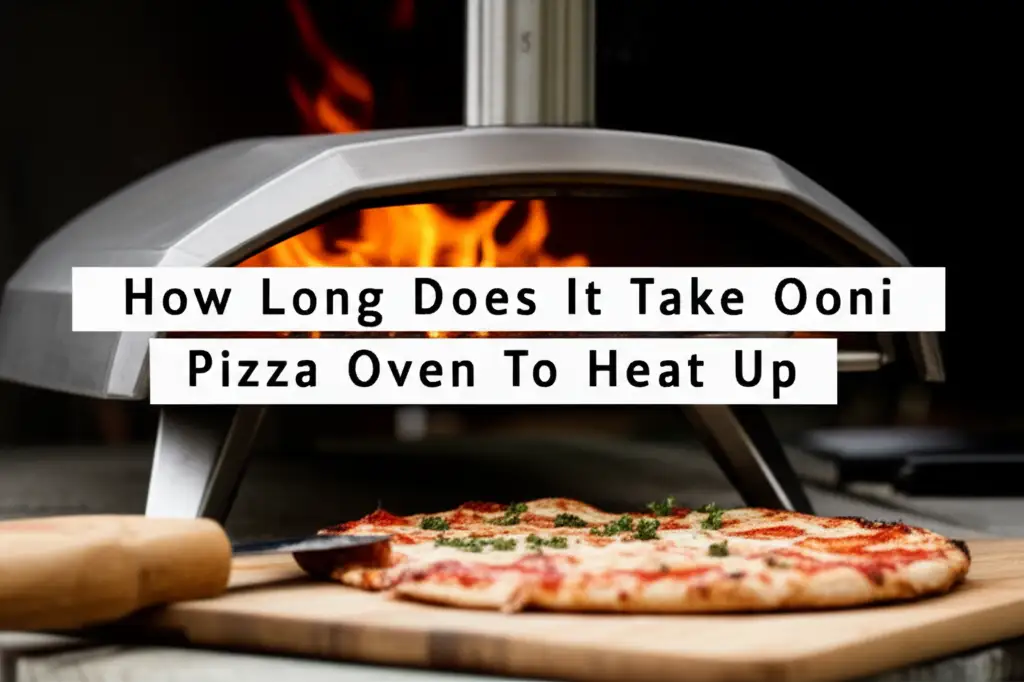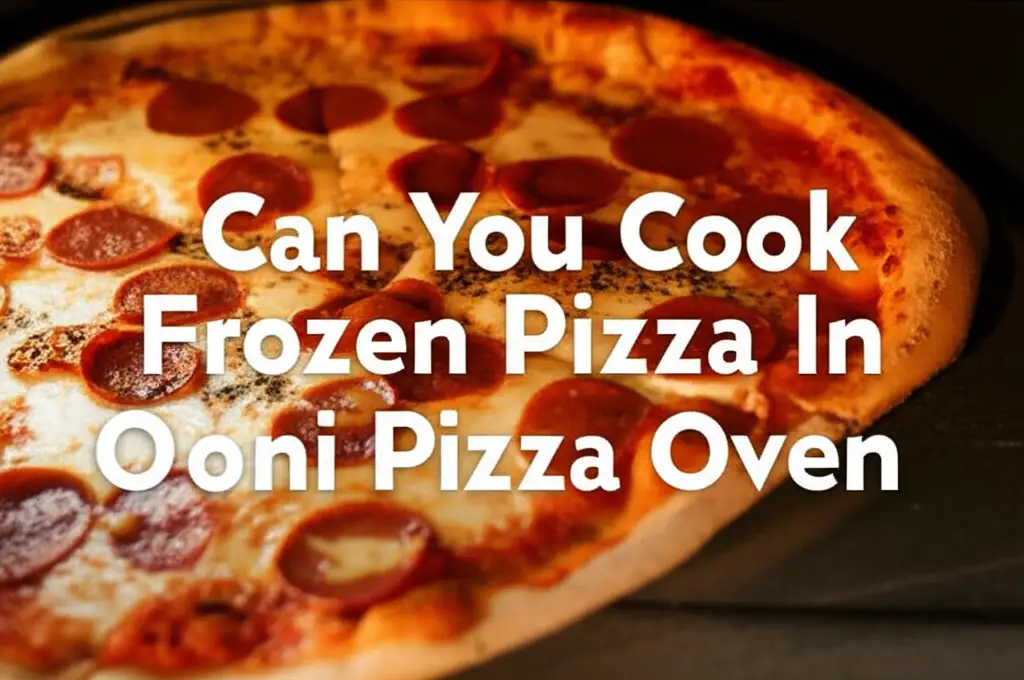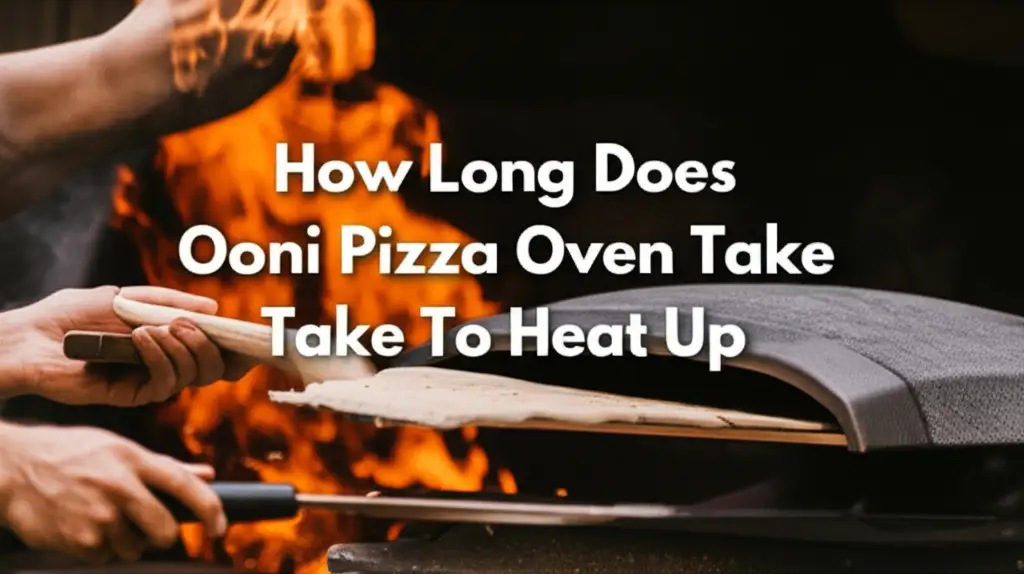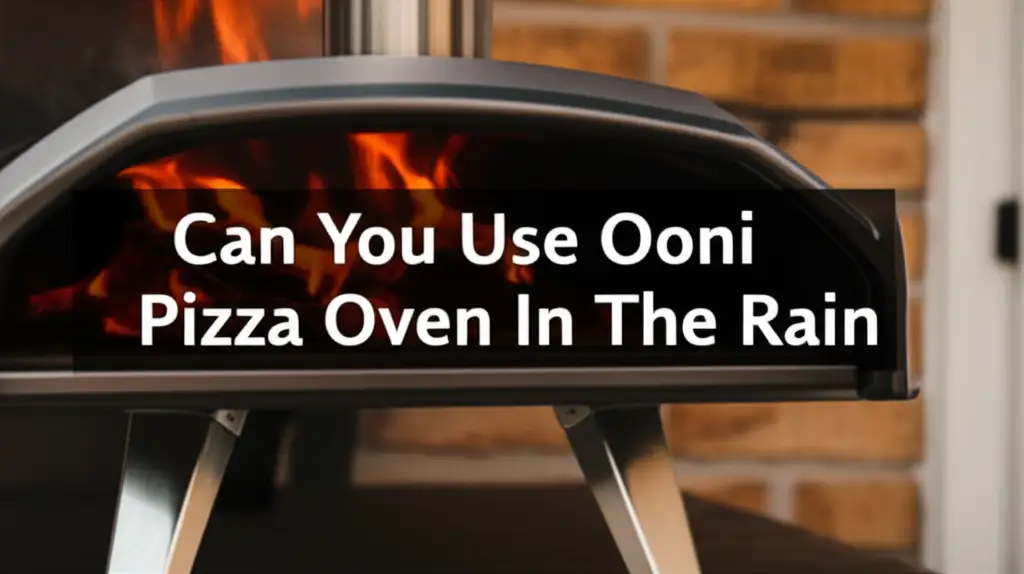· Todd Martin · Pizza Ovens · 16 min read
How Long Does It Take Ooni Pizza Oven To Heat Up

How Long Does Your Ooni Pizza Oven Heat Up?
Imagine the irresistible aroma of freshly baked pizza wafting through your backyard. You dream of crisp crusts, bubbly cheese, and perfectly charred toppings. Ooni pizza ovens make this dream a reality, delivering restaurant-quality pizza right at home. A common question among new and aspiring Ooni owners is: “How long does it take Ooni pizza oven to heat up?” Understanding this process is key to mastering your outdoor pizza experience.
This article will explore the factors that influence Ooni heat-up times. We will look at different Ooni models, fuel types, and environmental conditions. You will also get practical tips to achieve optimal temperature efficiently. Let’s get your Ooni ready for action and start making incredible pizzas.
Takeaway: Get Your Ooni Hot Fast
- Ooni ovens typically heat up in 15-30 minutes.
- Fuel type is a main factor, with gas being fastest.
- Measure the stone temperature, not just air temperature, for readiness.
- Ambient conditions like cold and wind affect heating speed.
- Proper setup and pre-heating techniques can reduce waiting time.
Your Ooni pizza oven generally takes 15 to 30 minutes to reach its ideal cooking temperature of 850-950°F (450-500°C). This preheating time depends on the specific Ooni model, the fuel type you use, and the weather conditions outside. Always aim for a hot pizza stone for the best results.
Understanding Ooni Heat-Up Times
Getting your Ooni pizza oven to the right temperature is a critical step before cooking. This is not just about heating the air inside the oven. It is about bringing the pizza stone up to an extremely high temperature. A hot stone cooks the base of your pizza quickly and crisply.
Most Ooni models are designed to reach temperatures suitable for Neapolitan-style pizza. This means temperatures between 850°F and 950°F (450°C to 500°C). Reaching these temperatures ensures your pizza cooks in as little as 60-90 seconds. This fast cook time gives you that authentic, bubbly crust.
The heat-up time is an essential part of the pizza-making process. You want to avoid putting a pizza into an oven that is not hot enough. An underheated stone will lead to a soggy bottom and a less enjoyable pizza. So, patience during this initial heating phase pays off.
My personal experience shows that a well-preheated Ooni makes all the difference. I always use an infrared thermometer to check the stone temperature. This tool removes the guesswork and ensures I am ready to cook. Knowing the actual temperature makes me confident about placing my pizza inside.
Factors Influencing Ooni Heat-Up Speed
Several elements play a role in how quickly your Ooni pizza oven reaches cooking temperature. Understanding these factors helps you optimize your preheating process. You can then manage your time better and get to pizza perfection faster. Let’s look at the key influences.
Ooni Model and Fuel Type
Different Ooni models use various fuel sources, and this largely determines their heat-up speed. Gas-powered ovens generally heat up the quickest. Wood-fired and multi-fuel models might take a little longer.
- Gas-Powered Ooni Ovens (e.g., Ooni Koda 12, Koda 16, Karu 12 with Gas Burner): These ovens often heat up the fastest. They can reach cooking temperatures in about 15-20 minutes. Gas provides a consistent, powerful flame that quickly brings the stone up to temperature. I find these models incredibly convenient for quick pizza nights.
- Wood Pellet Ovens (e.g., Ooni Fyra 12): Fyra models run on wood pellets, which offer a very consistent burn. They typically take around 20-25 minutes to heat up. You need to ensure the hopper is full and the pellets are burning well to maintain heat.
- Multi-Fuel Ovens (e.g., Ooni Karu 12, Karu 16): These ovens give you flexibility. When used with wood or charcoal, they might take 20-30 minutes to heat up. Adding the gas burner accessory can reduce this time, making them closer to gas-only ovens. The authentic wood-fired taste often makes the extra few minutes worth it.
- Electric Ovens (e.g., Ooni Volt 12): The Volt 12 is an indoor/outdoor electric oven. It heats up quickly, usually within 20 minutes, offering precise temperature control. It brings Ooni speed to any setting with an electrical outlet.
Knowing your specific model and its fuel type helps set realistic expectations for heating. Each Ooni design prioritizes different aspects, from speed to traditional flavor.
Ambient Temperature and Weather Conditions
The weather outside directly impacts your Ooni’s heat-up time. A cold day or strong winds will make your oven work harder to reach temperature. The oven loses heat to its surroundings, requiring more energy to compensate.
- Cold Weather: In colder temperatures, your Ooni will take longer to heat up. It must overcome the chill in the air and the cold surface it sits on. I notice a significant difference on chilly evenings compared to warm summer days. Plan an extra 5-10 minutes for preheating in winter.
- Wind: Wind can be a major heat thief. It pulls heat away from the oven’s body and out of the mouth, slowing down the preheating process. If possible, position your Ooni in a sheltered spot. You can also build a wind break around it.
- Rain/Dampness: While Ooni ovens are durable, moisture can affect preheating if it gets into the oven. Ensure your oven and stone are dry before lighting. Using an Ooni pizza oven table can help keep the oven off the ground and away from puddles.
Protecting your Ooni from harsh elements is a good practice. This not only helps with faster heat-up but also extends the life of your oven. Remember, the oven’s exterior also gets hot during operation. Knowing how hot the outside of an Ooni pizza oven gets can help you plan your setup safely, especially regarding windbreaks or nearby objects.
Pizza Stone Condition and Material
The pizza stone inside your Ooni is crucial for cooking. Its condition and how it retains heat affect your heat-up time. Ooni ovens use a high-quality cordierite stone, known for its thermal shock resistance.
- Stone Material: Cordierite stones absorb and retain heat very well. They are designed for rapid heating and cooling cycles. This material helps ensure even heat distribution to your pizza crust.
- Initial Temperature of the Stone: If your Ooni has been stored in a cold garage, the stone will be very cold. A cold stone takes more energy and time to heat up to optimal temperature. Think of it like a cold cast iron pan taking longer to heat than a warm one.
- Cleanliness of the Stone: A clean stone heats more efficiently. Food residues can insulate the stone, preventing it from reaching maximum temperatures evenly. Regularly cleaning your Ooni stone helps maintain its performance. You can find tips on how to clean Ooni stone to keep it in prime condition. Similarly, general knowledge on how to clean pizza stone is helpful.
A well-maintained and clean pizza stone is essential for quick and effective preheating. It ensures consistent cooking results every time you use your Ooni. I always give my stone a quick scrape after it cools down to keep it ready for the next session.
Achieving Optimal Ooni Pizza Oven Temperature
Hitting the right temperature for your Ooni pizza oven is more than just waiting a set number of minutes. It is about ensuring the stone itself is hot enough. This is where most people get confused, thinking the air temperature is the only thing that matters. For perfect pizza, the stone’s temperature is king.
The ideal temperature range for Neapolitan-style pizza in an Ooni is typically 850-950°F (450-500°C). At these temperatures, your pizza cooks incredibly fast, developing a crispy base and a beautifully charred crust. This rapid cooking also creates the signature airy texture. If the stone is not hot enough, the base of your pizza will be soggy. This happens because the dough spends too much time on the stone without quickly crisping up.
To accurately measure the stone temperature, you need an infrared thermometer. Ooni sells its own, or you can find one easily online. Simply point the laser at the center of your pizza stone after the oven has been running for the recommended time. I always scan different spots on the stone to ensure even heating. This little tool has saved many pizzas from a sad, undercooked fate.
When you first start your Ooni, you will see flames engulfing the oven. This quickly heats the air inside. However, the stone needs time to absorb that heat. It acts like a thermal battery. Give it those extra few minutes, even after the flames look strong. Waiting for the stone to reach its peak temperature will make a huge difference in your final pizza quality. This precision helps achieve results similar to professional ovens, which are built for sustained high heat.
Tips for Faster Ooni Preheating
Everyone wants to get to the pizza-making part quickly. While Ooni ovens are already fast, a few techniques can help you shave off precious minutes from your preheating time. These tips ensure your oven is ready for that first glorious pizza even sooner.
- Start with Dry Fuel: If you are using wood or pellets, ensure they are completely dry. Wet fuel creates a lot of smoke and struggle to burn hot, extending heat-up time. I always store my wood pellets in a dry, airtight container. This way, they are ready to go whenever I am.
- Use the Door (if applicable): Models like the Karu and Fyra have a door. Keep the door closed during preheating. This traps heat inside the oven, allowing it to build up more quickly. Once you are ready to launch pizzas, you can open the door.
- Position for Protection from Wind: Wind can significantly reduce your oven’s efficiency. It draws heat away from the oven. Try to place your Ooni in a sheltered area, perhaps against a wall or using a temporary windbreak. This simple step can shave off several minutes from your preheating time. A dedicated pizza oven table can help with optimal placement and stability.
- Allow for Initial Burn-Off: For wood-fired ovens, allow the initial flames to establish themselves fully. For gas ovens, turn the flame to maximum right away. Do not rush this initial phase. Give the fuel a chance to get going before expecting rapid temperature rise.
- Clean Your Stone Regularly: As mentioned, a clean stone absorbs and radiates heat more effectively. Over time, burnt-on food can accumulate on your stone. This acts as an insulator, making it harder for the stone to reach and maintain high temperatures. Regular cleaning, following guides like how to clean Ooni stone, prevents this issue.
By implementing these straightforward tips, you can optimize your Ooni’s preheating process. This means less waiting and more delicious, perfectly cooked pizzas for you and your guests. My focus is always on getting that stone screaming hot, and these methods help me achieve it consistently.
Understanding Heat Retention and Recovery
Once your Ooni pizza oven is at the optimal cooking temperature, its ability to retain heat and recover quickly between pizzas becomes vital. This feature sets Ooni ovens apart and allows for continuous pizza making without long pauses. It ensures your second, third, and fourth pizzas are just as good as the first.
Ooni ovens are designed with excellent insulation. This insulation minimizes heat loss from the oven body. This means that once the oven is hot, it stays hot efficiently. For instance, while you might wonder how hot does the outside of an Ooni pizza oven get, the insulation keeps the exterior relatively cooler than the interior, preventing excessive heat loss from the cooking chamber. Good insulation is why Ooni ovens can cook pizzas so quickly.
Heat recovery refers to how fast the pizza stone regains its high temperature after a pizza is cooked. When you launch a cool pizza onto the hot stone, the stone’s temperature drops slightly. A good oven recovers this lost heat rapidly. Ooni ovens are engineered for quick recovery. This allows you to cook multiple pizzas back-to-back without significant waiting times. You just need a short pause, typically a minute or two, for the stone to reheat.
For continuous pizza parties, this fast recovery is a game-changer. You do not want hungry guests waiting around. My strategy is to have my next pizza ready to launch as soon as the previous one comes out. This keeps the flow going and maintains the oven’s high temperature. It also helps in achieving consistent cooking results for every pizza.
First-Time Use and Seasoning Your Ooni
Your very first experience with an Ooni pizza oven is exciting. Before you start cooking pizzas, it is important to properly set up and “season” your oven. This initial process ensures the oven is clean and ready for food contact. It also helps prepare the stone for optimal performance. Think of it as a crucial first step for longevity and flavor.
For the first use, you should run your Ooni pizza oven at its highest temperature for at least 30 minutes. This process is often called “seasoning” or “curing” the oven. It burns off any manufacturing oils or residues that might be present. It also ensures the cordierite pizza stone is thoroughly heated and ready to handle extreme temperatures. This initial high heat helps the stone expand and contract uniformly, which strengthens it over time.
You can learn more about this process by following guidelines on how to use an outdoor pizza oven for the first time. These instructions typically cover safely lighting the oven and letting it run empty. It is a simple step, but it is vital for the oven’s long-term health and your food’s safety.
During this first burn, you might notice some light smoke or odors. This is completely normal and indicates the residues are burning off. Ensure you operate the oven in a well-ventilated outdoor area during this process. After the initial burn-in, let the oven cool down completely before its first cooking session. This prepares it fully for many delicious pizzas to come.
Troubleshooting Slow Heat-Up
Sometimes, your Ooni pizza oven might take longer than expected to reach temperature. This can be frustrating, especially when you are eager to cook. Several common issues can cause a slow heat-up. Identifying and fixing these problems quickly will get you back to making pizza fast.
One common reason for slow heating in a gas-powered Ooni is insufficient gas flow. Check your propane tank. Is it full enough? Sometimes, if you open the tank valve too quickly, the gas regulator can “safety shut-off.” This reduces gas flow. To fix this, turn off both the oven and the tank valve. Wait a few minutes. Then, slowly open the tank valve all the way, and then turn on the oven. This usually resets the regulator and provides full gas flow. If you have experience with other heating appliances, this might feel similar to when your KitchenAid oven takes so long to heat up. The principles of proper fuel delivery and internal component function are similar.
For wood-fired or pellet-fired Ooni ovens, the issue might be with your fuel.
- Wet Fuel: As mentioned earlier, damp wood or pellets will struggle to burn hot. They will produce more smoke and less heat. Ensure your fuel is dry and stored correctly.
- Insufficient Airflow: Wood-fired ovens need good airflow to burn efficiently. Check that the chimney is clear and that the vents are open. A blocked chimney can restrict airflow and prevent proper combustion.
- Ash Buildup: If you have used your Ooni many times without cleaning, ash buildup can block airflow and reduce heat. Regularly remove ash from the fuel tray.
Another factor could be the ambient temperature. If it is a very cold day, or if there is a strong wind, your Ooni will naturally take longer to heat up. It must fight against the external elements. Try positioning your oven in a more sheltered spot. A slight breeze is okay, but a strong gust can significantly impact heating.
Finally, ensure your pizza stone is clean. Burnt-on food debris acts as an insulator, preventing the stone from absorbing heat efficiently. Regular cleaning of your stone will help maintain optimal heat transfer. By addressing these potential issues, you can usually get your Ooni back to its quick heating performance.
FAQ Section
1. Can I speed up Ooni heat-up significantly?
Yes, you can speed up Ooni heat-up with a few simple steps. Ensure you use dry fuel and position the oven away from strong winds. Close the door on models that have one, like the Karu or Fyra, during preheating. Using an infrared thermometer to check the stone’s temperature also helps avoid underheating.
2. How do I know my Ooni is ready for cooking?
Your Ooni is ready when the pizza stone reaches 850-950°F (450-500°C). Use an infrared thermometer to measure the stone’s temperature at its center. The flames should be consistent and rolling across the top of the oven. Visually, the oven should look very hot and possibly have a slight shimmer.
3. Does ambient temperature affect Ooni heat-up time?
Yes, ambient temperature significantly affects Ooni heat-up time. In colder weather, the oven needs more time and energy to reach cooking temperature. Strong winds also pull heat away, slowing the process. Plan for an extra 5-10 minutes of preheating on cold or windy days.
4. How long does Ooni stay hot after turning it off?
After you turn off your Ooni, it will retain significant heat for about 30-60 minutes, depending on the model and external conditions. The pizza stone, in particular, holds heat well. It then cools down gradually over several hours until it reaches ambient temperature. Never touch the oven until it is completely cool.
5. Is it okay to leave my Ooni on for a long time?
Yes, Ooni ovens are designed for extended use at high temperatures. Many users keep their Ooni running for hours during pizza parties. This helps maintain consistent stone temperature for back-to-back cooking. Ensure your fuel source is sufficient for longer sessions. Always supervise the oven when it is in operation.
6. Why is my Ooni not reaching temperature?
Several reasons can cause your Ooni not to reach temperature. For gas ovens, check the gas tank level and ensure the regulator is not tripped. For wood or pellet ovens, use dry fuel and ensure proper airflow through the chimney and vents. Also, extreme cold or strong winds can prevent it from reaching peak temperature.
Conclusion
Understanding “how long does it take Ooni pizza oven to heat up” is a key part of your pizza-making journey. While the typical heat-up time is a quick 15-30 minutes, factors like your specific Ooni model, chosen fuel, and outdoor conditions all play a role. Gas ovens offer rapid heating, while wood and multi-fuel models deliver authentic flavors with a slightly longer wait. By paying attention to your pizza stone’s temperature and taking simple steps to optimize your setup, you can consistently achieve the ideal heat for perfect pizzas.
Embrace the joy of crafting delicious, restaurant-quality pizzas right in your backyard. With a properly preheated Ooni, every pizza will boast that signature crispy crust and airy interior. So, ignite your Ooni, give it the attention it deserves during preheating, and get ready to impress your family and friends with incredible homemade pizza. What are you waiting for? Your next perfect pizza awaits!





